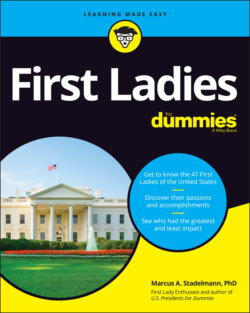Читать книгу First Ladies For Dummies - Marcus A. Stadelmann, Marcus A. Stadelmann PhD - Страница 21
Phase I (1789–1829)
ОглавлениеPart 2 of the book covers the First Ladies of this phase. Martha Washington set the foundation for First Lady obligations. On occasion, she played the part of head of state, and she set the precedent of being a great hostess who wasn’t involved in policy making.
Martha Washington’s role as First Lady was undefined. She herself didn’t know what to expect of the position. She was surprised when she received a 13-gun salute and shouts of “Long live Lady Washington!” when she arrived in the then-capital New York City. She decided to become the perfect hostess, because the democratic spirit of the time called for the president to open the doors of the executive mansion in New York City anytime. Soon this led to problems. Too many people took advantage of the open doors and just showed up. No work could get done, and no privacy existed. So it was decided to limit open houses and receptions.
Another hostess function was to deal with callers, usually the wives of Senators, House members, and foreign diplomats, who came to the door of the White House and left their cards. It was customary that a First Lady returned their visits. Often, First Ladies would have to make up to 60 visits a week. To make matters worse, the White House was open to everybody who wanted to show up on New Year’s Day, with the exception of wartime or periods of mourning. Thousands would stop annually, and the practice wasn’t stopped until the Hoover administration in 1933.
While Abigail Adams was an opinionated woman who influenced her husband in private, publicly she mostly fulfilled her hostess function. Dolley Madison was the first to help a widower, Thomas Jefferson, and then served eight years as First Lady. She dominated the White House for a long time. She was such a superior hostess that future First Ladies would ask her advice on becoming a hostess as late as 1845, but she also managed to mix the social part of being a hostess with the political part. Not only did she start the tradition of having an inaugural ball, but she also was truly nonpartisan at her receptions and everybody loved her for it. In addition, she called upon every wife of a Congressman and invited them to the White House, creating goodwill among the spouses of all Congressmen at the time.
The country’s early First Ladies were sweet, quiet, and gracious hostesses in public and played a supportive role to their husband, which reflected the times they lived in. In private, they displayed courage, had exceptional training, spoke foreign languages, read French philosophers, and traveled abroad creating goodwill for the U.S. in Europe.
